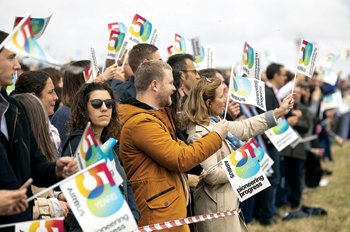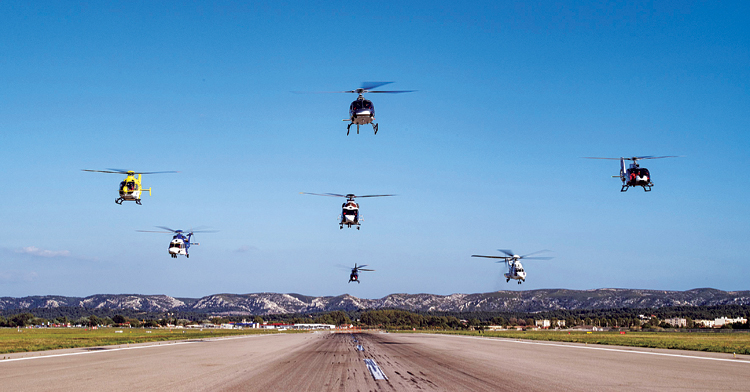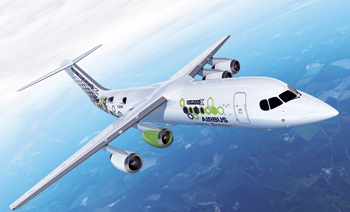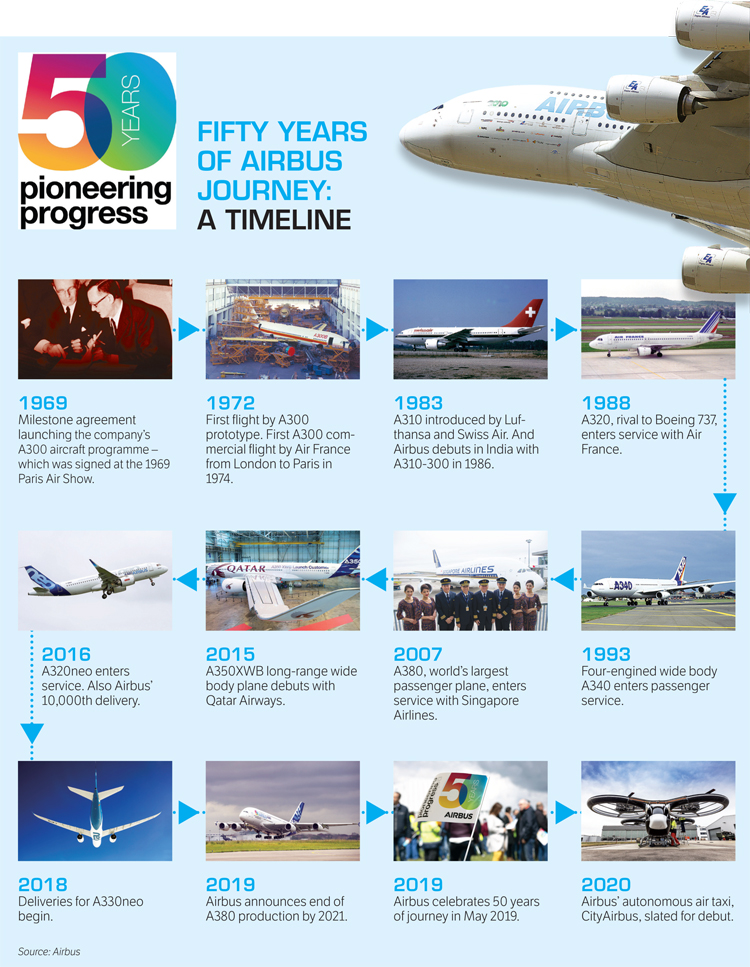Airbus Celebrates Five Decades of Aviation Transformation
Beginning with the world’s first wide body twin-engine jet airliner, the A300, Airbus has constantly marked many industry milestones as an aerospace giant through its extraordinary journey of 50 years

And it all began with a signature, the European multinational aerospace corporation, Airbus nostalgically notes on its website to mark 50 years of its eventful existence. A signature that made Europe fly with the determination for aerospace autonomy and a collective desire to explore new horizons. It has been five decades of an eventful journey that was transformative not just for Airbus itself in its rise as a global aerospace giant but also the international aviation industry, particularly the civil aviation domain.
It was on May 29, 1969 at the Paris air show in Le Bourget, when a consortium of European aerospace manufacturers came together to sign a historic agreement and went ahead with the ‘Airbus Project’ to develop an aviation complex to challenge the virtual monopoly of the United States.
With the launch of the world’s first wide-body, twin engine jet airliner, the A300, Airbus Industries scripted a success story of a dimension far beyond the imagination of its founding fathers. Airbus managed to place its European manufacturing consortium on the map and transformed the design scene for wide bodies.
THE BEGINING
The term ‘Airbus’ was coined in the early 1965 when representatives from France, German and UK aerospace industries met at Sud Aviation’s Paris office to forge a collective to build a new generation of high capacity jets.
AIRBUS’ 50 YEARS CELEBRATION

- As a tribute to Airbus’ successful 50 years, Airbus and the Acrobatic Patrol of France teams took the sky and kick started the celebrations through an aerial display
- To mark the 50 years of celebration, Airbus is unlocking a new moment in its story every day for the next 50 days.
“We were all concerned about the term ‘air bus’, which tended at the time to be used for any wide body airliner. The word stuck to us; it was something that was recognizable in all three languages,” remembered Arthur Howes, who was a young engineer at the Hawker Siddeley Future Projects department, and was one of two UK representatives at that meeting.
After receiving a formal go- ahead, plans began to materialize for construction of a “300-seat twin engine aircraft”. Airbus A300 was the first aircraft to be thus developed and manufactured with Robert Béteille as the project’s original technical director.
The aircraft was designed to be smaller, lighter and more economical than its US competitors. There were certain innovations that made this aircraft different - its wide body and raised cabin floor allowed the operating airlines to increase profitability by carrying more cargo.
The wings of the aircraft, that were designed by Hawker Siddeley, provided greater lift to the aircraft enabling it to climb faster and attain a level cruise altitude sooner than any other passenger aircraft, giving cabin crew more time for in-flight service.
The plane could hold upto 270 passengers and had a range of 1,200 nautical miles. The name A300 was kept to reflect the intended passenger capacity of 300.
The breakthrough moment came for Airbus in September 1970 with Air France becoming the first customer for the aircraft. The A300 performed its first commercial flight on May 23, 1974, flying from London to Paris for Air France.
THERE ON, THERE WAS NO STOPPING AIRBUS
Sales for the A300 were initially slow but picked up pace when US carrier Eastern Airlines leased four aircraft in 1977. Frank Borman, the then CEO of the airline, was surprised at how “economical” the fleet was. The company then went on to order 23 of the same A300s. Within its first decade, its order book and customer base began to expand.
RELENTLES EXPANSION
A smaller A300 derivative, the A310, arrived in 1983, playing a significant role in establishing a bigger profile for Airbus. The company then produced the Airbus A320, the first subsonic airliner with a fly-by-wire flight control system. It made its debut in May 1984, finally putting Airbus on a level playing field with its US rival Boeing.
To build on the phenomenal success of the A320 family, Airbus launched the re-engined A320neo in 2010, powered by Pratt & Whitney’s PW1000G geared turbofan (GTF) and CFM International’s advanced Leap-1A engines. Since the iconic Airbus A320 accounted for a majority of the company’s sales, it was not an easy decision for the company to launch a new variant for the same model. But this decision was endorsed by commercial success, with the A320neo subsequently accounting for over 40 per cent of all A320 sales.

EXPLORE EXTREME EDGES
- 10 years ago the Airbus Corporate Jetliner ACJ319 flew scientists to Antarctica to facilitate research. The feat marked the first time a commercial airliner had flown to Antarctica, and meant that the ACJ had to land on a runway of ice.
- On 10 July 2015, Airbus made history when the E-Fan 1.0 conducted the first fully electric flight across the English Channel. In doing so, the E-Fan proved that electric and hybrid electric flights are a viable, even inevitable, future for the aerospace industry.
- Europe’s first mission to Mercury – BepiColombo, which lifted off in October 2018 on a journey to the solar system’s smallest and least-explored terrestrial planet, was an industrial consortium of 83 companies from 16 countries led by Airbus.
After the production of the A320 in the mid-80’s the company turned its attention to establishing an extensive wide body lineup of aircraft. Jean Roeder, who was the chief engineer of Airbus at that time, created the blueprint for the Airbus wide body fleet, leading to the introduction of the A330/A340 family. This led to new wing design and development of engine technology.
The Airbus A330 is a medium-to-long range wide body twinengine jet airliner developed in parallel to the four-engined A340. It was also the first variant of Airbus to offer three engine options: General Electric CF6, Pratt & Whitney PW4000, and Rolls-Royce Trent 700.
A330-300, its first variant took flight in November 1992, and entered passenger service in January 1994.
Due to the slow sales faced by the A330-300, Airbus launched the short fuselage longer range -200 version in 1995. It made its debut in 1998 and gave direct competition to the Boeing 767-300ER.
The A340, the A330’s twin long range wide body commercial passenger airliner entered service in 1993. The A340 enjoyed moderate success before the launch of Boeing’s 777 that became the market bestseller.
Airbus turned its attention to building alternatives to Boeing’s most successful and iconic aircraft, including the 747 jumbo jet. The new A380 or A3XX, as it was known at the time of its launch, was envisaged in 1990 as the world’s largest passenger airliner which would eclipse the Boeing 747.
IT WAS ON MAY 29, 1969 AT THE PARIS AIR SHOW IN LE BOURGET, WHEN A CONSORTIUM OF EUROPEAN AEROSPACE MANUFACTURERS CAME TOGETHER TO SIGN A HISTORIC AGREEMENT AND WENT AHEAD WITH THE ‘AIRBUS PROJECT’ TO DEVELOP AN AVIATION COMPLEX TO CHALLENGE THE VIRTUAL MONOPOLY OF THE UNITED STATES
The gigantic aircraft materialised in the mid-2000s, and Singapore Airlines became its first operator in 2007. Certified to carry up to 853 passengers, the full-length double-deck aircraft has a typical seating capacity of 525. It is powered by four Engine Alliance GP7200 or Rolls-Royce Trent 900 turbofan engines providing a range of 14,800 km.
The sheer dimension of the A380 have earned it a place in aviation’s hall of fame. But the huge break-even passenger numbers became a limiting factor, and it became difficult for airline’s to operate this fleet profitably. Emirates kept the faith for a decade and remained the biggest operator of the A380. But eventually, when Emirates too succumbed to market economics and curtailed the size of its order, Airbus in February 2019 announced an end to the production of this Herculean aircraft after 2021 due to lack of further orders.
Over the five decades of its existence, Airbus has undergone exceptional evolution, which is visible from its range of commercial fixed-wing aircraft starting from the A300s to the A380 and the ‘outsized’ cargo aircraft, Beluga.
AIRBUS CHOPERS
Airbus not only made its mark in the fixed wing passenger market but also emerged as a global leader in the helicopter category. With customers in over 150 countries, Airbus dominates the civilian helicopter segment with a market share of 54 per cent and boasts of the largest product range in this category.
It boasts of the world’s largest helicopter product range. Among its bestsellers is the iconic AS365 Dauphin, the fastest transport helicopter in the world with a speed record of 372 km per hour.
AIRBUS IN INDIA
Airbus made its debut in India in 1986 when Indian Airlines started operating the A310-300. Since then, Airbus has claimed a sizeable chunk of the narrow body, single aisle category in India while the long-haul airplane market continues to be dominated by Boeing.
The entire narrow body fleet of IndiGo, India’s largest domestic airline comprises A320-200, A320neo and A321neo. Airbus also got its largest single order in is history from IndiGo, which signed a $27 billion contract in 2015 for 250 Airbus A320neo aircraft.
The ‘Make in India’ agenda is a growing part of the company’s business strategy in India. Local sourcing, engineering, innovation, training and maintenance are increasingly playing a key role in the market.
AIRBUS VERSUS BOEING
The competition between Airbus and Boeing has long established a duopoly in the aviation industry with both companies having control of 99 per cent of the large plane market. Although, Airbus didn’t become a significant competitor to Boeing until the 1990s, the two have had a long withstanding competition ever since.
Airbus became a strong competitor to Boeing with the launch of the Airbus A320, which took on the Boeing bestseller, the 737. Riding on the A320, Airbus has a far more broad-based revenue geography than Boeing, which still has most of its sales centred around the US and the Asia-Pacific.
ON THE EDGE OF TOMORROW
Being the coming of age organisation that it has been, Airbus is also constantly striving to come with technical innovations that transform the air travel in the future.
- One such example is its multi-passenger autonomously piloted electric vertical take-off and landing (eVTOL) vehicle designed for urban air mobility (UAM), the CityAirbus. The vehicle explores the potential of UAM in the fields of connectivity, artificial intelligence, autonomous systems, and electric propulsion and is scheduled for commercial operation in 2020.
- Airbus is evaluating hybrid-electric propulsion concepts as well for regional commercial aircraft through the E-Fan X demonstrator programme designed to be the world’s most powerful flying generator with a 2.5-megawatt serial-hybrid propulsion system.
- Airbus is also developing an enhanced flight vision system (EFVS) with the aim of improving airport access regardless of weather or ground landing aids.

Product reliability is an important factor for both the giants. While Airbus aircraft have suffered no major grounding, Boeing has had to deal with the crisis of confidence in its bestselling 737 Max 7 following two recent fatal crashes of this variant involving the Indonesian- Lion Air Flight 610 and Ethiopian Airlines Flight 302 – which killed all 346 persons on board aboard.
These crashes were attributed to a faulty software on the auto-pilot, which put both the ill-fated aircraft on an irreversible nosedive. Indeed, these crashes created a full blown crisis for Boeing, which was forced to ground the entire 737 Max 7 fleet across the world in March 2019 to sort out the fatal software glitch.
The Boeing 737 Max 7 crisis itself has its roots in its rivalry with Airbus. Anxious to match the innovation on the A320neo, Boeing also attempted an improvisation on the Boeing 737 by fitting a new fuel efficient engine on the old airframe. The problem with this modification was that the 737 did not have the height of the A320. In order to make it work, the bigger new engines were fitted in a manner which rose above the wing level. This disturbed the aerodynamics of the aircraft, making the nose rise in some situations. To control this, a Manoeuvering Characteristics Augmentation System (MCAS) software was installed on the autopilot to correct the unintended rise. This software went rogue, leading to both the disastrous crashes. There were more damaging disclosures that pilots of these new variant were trained only on IPad capsules, and had not undergone any simulation training to recover the aircraft in the event of a software glitch.
The quick growth of Airbus can be attributed to state support. This has led to legal contest, with respective sides suing for unfair trade practice.
The US government filed a case in 2006 against the EU subsidies worth $22 billion to Airbus for development of new projects. The verdict of the WTO confirmed illegal subsidies to Airbus to the tune of $18 Billion.
THE A300 PERFORMED ITS FIRST COMMERCIAL FLIGHT ON MAY 23, 1974, FLYING FROM LONDON TO PARIS FOR AIR FRANCE.
In retaliation, the EU filled a counter case against the US, alleging the state had provided $23 billion indirect subsidies to Boeing.
This has led to a full blown state-supported American trade war against Airbus, with the US demanding annual penalties of $11 billion be imposed by the WTO on Airbus as “counter measures”. This threatens to wound Airbus and blunt its competitive edge.
FUTURE FOR AIRBUS
Airbus is poised to make a leap into urban transport, which promises to revolutionise commuting (See Box). It intends creating an air taxi space in urban transport with a futuristic electrically powered, auto flown vertical take-off and landing craft (eVTOL). They intend introducing these sci-fi flying vehicles as early as in 2020.
Another far reaching initiative is on hybrid-electric propulsion for regional aircraft. It is also working on an enhanced flight vision system (EFVS) for safe landings irrespective of bad weather or availability of ground landing aids.
With its new CEO Guillaume Faury adopted an “aggressive mindset for eliminating inefficient practices and cutting down on costs”, Airbus promises to not only give stiffer competition to Boeing but also protect its turf from emerging competition.






